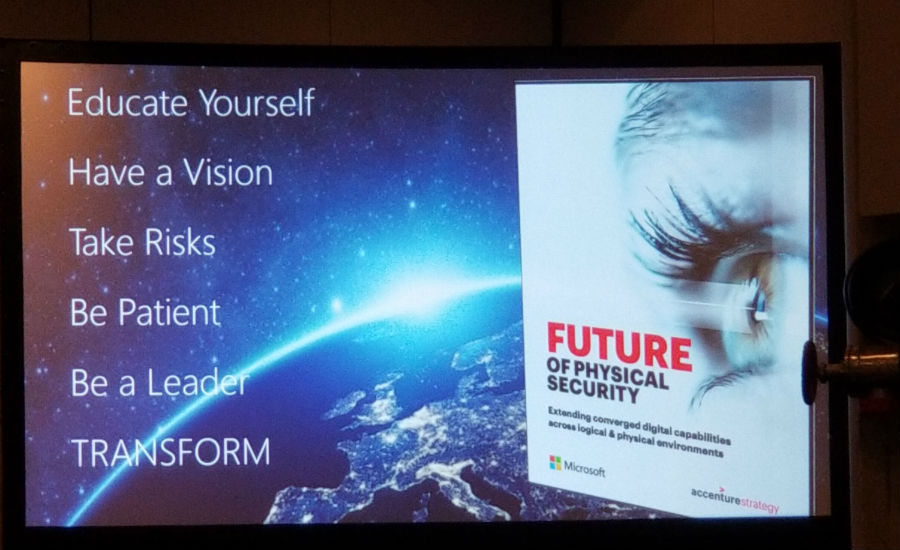Are YOU Prepared for the Digital Transformation of Security?




Yesterday’s Keynote speaker, Philip Halpin, senior vice president and head of global security, Brown Brothers Harriman (BBH), invited attendees to think critically about the concept of transformation in his presentation, “Friend or Foe? Technology Disruption and the Physical Security Industry.”
Halpin was introduced by SIA CEO Don Erickson, who noted that Halpin has transformed BBH’s security program, taking it from proactive to reactive, and is now on a mission to digitally transform the way BBH manages physical and logical identity.
Halpin began by asking the central question of the presentation: will technology disruption be helpful or harmful to the security industry? When asked to weigh in, more of the attendees agreed it was helpful; but many abstained from answering, seeming hesitant. This was not surprising, according to Halpin. “People aren’t that comfortable with change,” he said. “It is disruptive and unsettling; but we must change.”
One key reason is that we won’t have a choice, he said. He described the concept of exponential growth and how it would affect the security industry. “Technology has already changed how we work and live and now it is clearly poised to disrupt the physical security industry,” he said. “For example: robots, drones, automation and artificial intelligence will all transform the industry.”
What’s more, it will happen at a speed that is almost unfathomable.
“Are we in the fourth industrial revolution? Let’s look at examples,” he said. “Mobile, super computers, robots, self-driving cars, artificial intelligence, genetic engineering -- I am kind of thinking we are there. The key is in the speed of all these. Things are happening much faster. Before there were big things happening, but there were 100 years in between them. Now every week there is something new occurring.”
Part of the trouble with conceiving of this is that humans think very linearly, he explained.
“Exponential growth doesn’t work that way. It is in multiples. The rate of technology innovation is doubling every year.” That means in one year we are at two years of advancement. In year two we are four. By year 7 we are at 128 years of advancement; but shockingly, he said, “by the time we are at year 10 we are at 1,000 years of technological advancement! Ten years from now we will be 1,000 years ahead of where we are now. This is a transformation period and everything is going to change.”
What does this mean for the security industry? Halpin said that, like the journey of 1,000 miles that begins with a single step, digital transformation is also a journey that should be broken into accessible pieces, with cultural, procedural and process changes. “It’s about transforming fundamentals of business to stay competitive in a digital time.”
He also shared another somewhat alarming statistic: 47 percent of companies believe their traditional business model will be obsolete by 2020.
“When I am home or using my iPhone, I am living in a different world; but when I go to work I go back to the 1950s,” Halpin said. “Why am I living this different experience? That is a big part of why that will change rapidly. Younger people demand a different type of experience in their workplace. We have to start creating these experiences and security organizations must act on some key trends.”
The three key trends he pointed to are:
- Consumers demand digital, and all of us are consumers;
- If you are not data driven you are falling behind; and
- Technology will disrupt from the outside in.
“If you think about disruption, the way we are doing things today is not going to exist tomorrow,” he said. “We will have a much better way of doing things. But we have to start thinking about it, planning for it and building it.”
He ended by giving his answer to the question he began with. “I think there is a real opportunity for security industry practitioners and innovators to harness this wave with this digital mindset and thought process and evolve security to become the intelligence platform for the enterprise. Security organizations are enterprise-wide, and typically have a fairly good reputation in the industry for buying things that add value to the business.”
The key steps, he concluded are: educate yourself; have a vision; take risks; be patient; be a leader; and, finally, transform.
While the security industry is not always known for fast transformation, Halpin left the audience with this food for thought, when asked by an attendee how to get buy-in:
“My approach has been that at a certain point in time the smallest thing my physical access control system is going to do is actually open the door. It is about the data. The rich data I can pull, such as ‘Are these two people ever at the office at the same time? Do we really need two desks in Manhattan?’ help market your department and show the ROI. Everything I have added has paid for itself. This is not pie in the sky. This stuff works. It’s about figuring out how to message it.”
Looking for a reprint of this article?
From high-res PDFs to custom plaques, order your copy today!





.png?height=200&t=1651072917&width=200)


